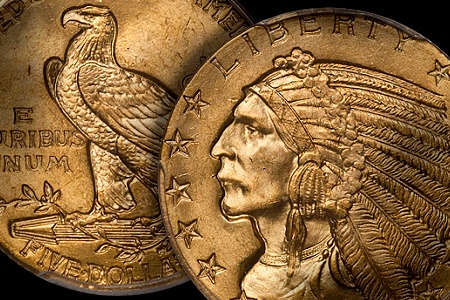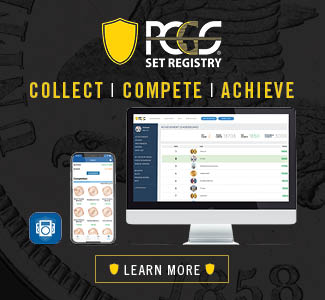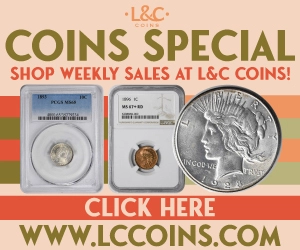By Doug Winter – RareGoldcoins.com
CoinWeek Content Partner……….
I am generally not a participant in the generic gold market as I tend to favor scarce and rare dates over more common ones. But I like Indian Head half eagles a lot and a recent experience made me ask the question: “is it time to buy Indian Head half eagles?”
 I bought a nice, fresh deal of Indian Head half eagles about six weeks ago. All were in very old holders and I broke them out and sent them off to grading. My results were excellent and nearly every coin graded MS64 or MS65. As I got ready to cash in on my windfall, I did some price research and was shocked. Unless they stickered at CAC (more on this in a few moments) the levels I was going to have to sell them left me breathless…and not in a good way.
I bought a nice, fresh deal of Indian Head half eagles about six weeks ago. All were in very old holders and I broke them out and sent them off to grading. My results were excellent and nearly every coin graded MS64 or MS65. As I got ready to cash in on my windfall, I did some price research and was shocked. Unless they stickered at CAC (more on this in a few moments) the levels I was going to have to sell them left me breathless…and not in a good way.
If you are like me and you don’t really follow the generic market on a day-by-day basis, it can be mystifying to see how cheap most issues have become in the last few years. My non-CAC MS64 Indian head half eagles were worth around $1700 per coin if they were in NGC holders and a bit more in PCGS holders. I was more shocked at how cheap MS65’s have become: around $9,000 for NGC coins and a smidge over $10,000 for PCGS coins. And that’s not to mention the fact that you basically have to twist buyer’s arms to get them to buy any quantity of these even at these cheap, cheap, cheap levels.
Why are Indian Head half eagles so inexpensive in MS64 and MS65? There are a number of answers.
1. Traditional Sellers of Generic Gold Now Sell Other Products
Firms like Blanchard, Swiss America, and Goldline used to sell lots of better quality generic gold coins; items such as MS64 or MS65 Indian Head half eagles. Today, they either sell few generics or if they do, they are focused on those coins with CAC approval. The supply of MS64 and MS65 Indian Head half eagles has stayed consistent as coins are continually found in Europe or upgraded from current holders. The demand has not kept up with the supply, however, and this has resulted in plummeting prices.
2. Owners of Generic Gold Don’t Want to Cost Average Their Positions
Let’s say you bought a few nice MS65 Indian Head half eagles for $15,000 each back around 2006-2007. You are clearly not a happy with today’s prices so much lower than when you purchased your coins. But why not by a few more and use cost-averaging to lower your overall price point(s)? This logic makes sense to me, but for most coin investors it is exactly what they do not want to do. They feel “burned” by Indian Head half eagles and probably want nothing more to do with them. This lack of continuity in the generic market, due to poor price performance, has clearly not helped this market.
3. The CAC Effect
One of the primary reasons why CAC was created was to identify those generic gold coins, particularly in series such as Indian Head half eagles, where the perception was that many coins in MS64 and MS65 holders were over-graded or not, at the very least, “solid” for the grade. CAC has proven to be very tough on Indian Head half eagles, and only a small percentage of the MS64 and MS65 coins sent in for approval have received a green sticker. As a result, stickered MS64 and MS65 Indian Head half eagles sell for very strong premiums; in most cases 25-50% over non-stickered coins. The market perception of non-stickered MS64 and MS65 Indian Head half eagles is they are not “good” coins and, as a result, the price gap between non-CAC and CAC stickered generic gold coins is widening. My gut feeling is that non-stickered MS65 Indian Head half eagles could ultimately be worth half as much as their CAC’d counterparts.
4. The Plus Grade Effect on MS64
It is a matter of opinion whether coins graded MS64+ are actually “better” than coins graded MS64, but the market perception is such that plus-graded coins have begun to sell for significant premiums, even in the generic market. If you are a new collector and you are offered a “regular” MS64 Indian Head half eagle for $1,750, or an MS64+ example for $2,250, the chances are good that you will spend the extra $500 and get the “better” coin. This has clearly hurt the market for MS64 Indian Head half eagles, and it is likely that we will see further price separation between MS64 and MS64+ coins.
5. Changing Tastes Amongst Gold Coin Buyers
More than anything else, the generic gold coin market has been hampered by a lack of demand. Past generations of new collectors and investors were introduced to numismatics by the assembling of the basic 11 or 13 coin U.S. gold coin type set. Today, new collectors are more inclined to collect something which is rare. For $10,000, an AU 1864 half eagle (slightly over 4,000 struck and under 75 known in all grades) is a more sensible purchase than an MS65 1909-D half eagle (nearly 3.5 million struck and over 100 graded in MS65 at PCGS alone) in the minds of these new collectors. It will take a large marketing
So what is my conclusion? Is it time to buy Indian Head half eagles in MS64 and MS65? I’d like to say yes, but I think that prices could easily drop another 20-30% on these coins in the next year or two. In my opinion, if levels get down to $1,500 for nice MS64’s and $7,500 for MS65’s, I would jump in the market, likely in a big way. For now, I’d avoid this coin unless you need one for a gold type set or if you are a contrarian with some tolerance for risk.
What’s your take on the Indian Head half eagle series and generic gold in general? I’d love to hear from you and encourage you to add your comment(s) in the section below.
About Doug Winter
 Doug has spent much of his life in the field of numismatics; beginning collecting coins at the age of seven, and by the time he was ten years old, buying and selling coins at conventions in the New York City area.
Doug has spent much of his life in the field of numismatics; beginning collecting coins at the age of seven, and by the time he was ten years old, buying and selling coins at conventions in the New York City area.
In 1989, he founded Douglas Winter Numismatics, and his firm specializes in buying and selling choice and rare United States coins, especially US gold coins and all branch mint material.
Recognized as one of the leading specialized numismatic firms, Doug is an award winning author of over a dozen numismatic books and the recognized expert on US Gold. His knowledge and exceptional eye for properly graded and original coins has made him one of the most respected figures in the numismatic community and a sought after dealer by collectors and investors looking for professional personalized service, a select inventory of impeccable quality and fair and honest pricing. Doug is also a major buyer of all US coins and is always looking to purchase collections both large and small. He can be reached at 214-675-9897.
Doug has been a contributor to the Guidebook of United States Coins (also known as the “Redbook”) since 1983, Walter Breen’s Encyclopedia of United States and Colonial Coins, Q. David Bowers’ Encyclopedia of United States Silver Dollars and Andrew Pollock’s United States Pattern and Related Issues
In addition he has authored 13 books on US Gold coins including:
- Gold Coins of the New Orleans Mint: 1839-1909
- Gold Coins of the Carson City Mint: 1870 – 1893
- Gold Coins of the Charlotte Mint: 1838-1861
- Gold Coins of the Dahlonega Mint 1838-1861
- The United States $3 Gold Pieces 1854-1889
- Carson City Gold Coinage 1870-1893: A Rarity and Condition Census Update
- An Insider’s Guide to Collecting Type One Double Eagles
- The Connoisseur’s Guide to United States Gold Coins
- A Collector’s Guide To Indian Head Quarter Eagles
- The Acadiana Collection of New Orleans Coinage
- Type Three Double Eagles, 1877-1907: A Numismatic History and Analysis
- Gold Coins of the Dahlonega Mint, 1838-1861: A Numismatic History and Analysis
- Type Two Double Eagles, 1866-1876: A Numismatic History and Analysis
Finally Doug is a member of virtually every major numismatic organization, professional trade group and major coin association in the US.
If you are interested in buying or selling classic US coins or if you would like to have the world’s leading expert work with you assembling a set of coins? Contact Doug Winter at (214) 675-9897 or by email at [email protected].




